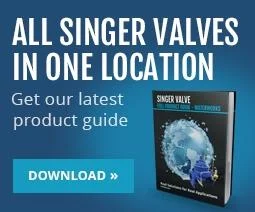
There are many options and several conditions that need to be considered when purchasing the right valve for a job. The more information from the field, the better the choice will be. The ultimate goal is to have the best valve for the job required at the most economical price. While it is not rocket science to do this, there is some fundamental information that needs to be taken into account to ensure the proper valve is chosen.
5 key questions you need to ask before you get started:
-
1. What is the purpose of the valve and what do we want the valve to accomplish?
-
2. What are the required flow rates? Both minimum and maximum need to be considered.
-
3. What type and size pipe will the valve be located on?
-
4. Will the valve be used continuously, intermittent, or momentary?
-
5. What are the operating pressures that the valve will be subjected to?
The ultimate goal is to choose the smallest valve that can do the job required which in turn will minimize cost, making sizing a very important aspect to get right. One of the most common ways to size a valve is to use the Cv method. As a reminder, Cv is the flow across a valve when there is 1 psi pressure differential across a fully open valve. With this in mind, it’s time to start:
- Determine the maximum and minimum flows that the valve will see. This is very important as a valve working below its minimum flow requirement may hunt and fluctuate, causing pressure spikes downstream, which can lead to pipe bursts.
- Determine the pressure differential (can you get specific, tools used). A good guide is to have a minimum of 5psi between inlet and atmosphere if the valve bonnet is being vented to the air, or 10psi if the bonnet cover is connected to the downstream.
- When you have this information the most common method for calculating size is to use the Cv method, using performance curves. To measure the flow through an open valve you can use the following formula:
Cv = Q/ Square Root of pressure differential
- After calculating the Cv for the application using the formula above, go to the manufacture’s catalog or data tables for the Cv valves of each size and model of valve. Always chose a valve that has at least the Cv value at the number calculated using the formula and your application requirements. It is always better to have a little safety so the CV of the valve you chose should have a higher value to give flexibility for the future if higher flows are ever desired.
Sizing Example using the Manual Cv method for a Pressure reducing valve:
We require to size a valve to handle 3500gpm Maximum Flow, Inlet Pressure is 100psi, Outlet Pressure is to be 70psi.
i. Solving for Cv
Pressure differential = 100psi – 70psi = 30psi
Flow(Q) = 3500 gpm Solving for Cv = 3500 / √30 Cv = 639
ii. Compare Cv and Flow Frequency Capabilities for Full Port (106) and Reduce Port (206) valves:
Table 1, S106 Full Port Valve Bodies

Table 2, S206 Reduced Port Valve Bodies
iii. Valve Selection:
Cv = 639, Maximum continuous Flow = 3500gpm
In this example the 10” 206 body is the best selection, as it meets the Cv requirement as well as the application meets the continuous flow recommendation for this valve. While the 8” S106 body meets the Cv requirement, the continuous flow recommend is below what is required for this application. Therefore if using the S106 full Port body, one would require using the 10” size as well. Full port valves cost more than a reduced port valve of the same size, therefore using the 10” 206 meets all the requirements as well is the one that is most economical.
- In any valve sizing exercise there is always an element of choice by the system designer. Is the flowrate given realistic? Are the pressures given accurate and proven? As the person responsible for sizing (while graphs, charts and even software calculators are necessary), having a clear understanding of the issues certainly makes for a more educated choice.
In conclusion, in order to size a valve correctly one must be sure to understand what the valve is required to do, what the system parameters are, and then use this information to pick the valve that will do a proper job while keeping the economic desires in mind. Basically, pick the smallest valve that can do the job properly. While in many instances making a valve larger than required is a safe choice, this is not always a good thing, especially when sizing specialty valves such as surge anticipation valves where over sizing can be very detrimental.








